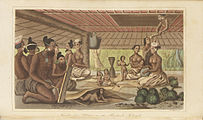Micronesians
| Total population | |
|---|---|
| 450,000 | |
| Languages | |
| Micronesian languages, Yapese, Chamorro, Palauan, English | |
| Religion | |
| Christianity (93.1%)[1] | |
| Related ethnic groups | |
| Polynesians, Melanesians, Euronesians, Austronesian peoples |
The Micronesians or Micronesian peoples are various closely related
Ethno-linguistic groups classified as Micronesian include the
Origins
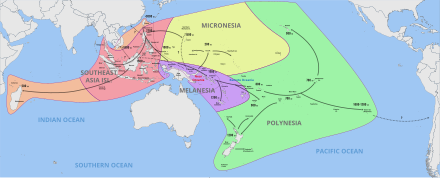
Based on the current scientific consensus, the Micronesians are considered, by linguistic, archaeological, and human genetic evidence, to be a subset of the sea-migrating
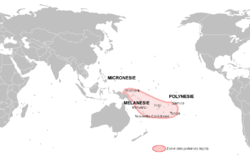
Migrants entered Micronesia from the east and the west. Migrants from the west came from the Philippines and Indonesia, and settled the Marianas around 3500 years ago, after which Palau was settled around 3000 years ago.[13]
Migrants from the east came from eastern
Yap was settled separately approximately 2000 years ago, as its language was brought by an Oceanic-speaking source in Melanesia,[16] perhaps the Admiralty Islands.[13]
Archeological evidence has revealed that some of the Bonin Islands were prehistorically inhabited by members of an unknown Micronesian ethnicity.[17]
List of ethnic groups
The Micronesian peoples can be divided into two cultural groups, the
Banaban people

Raobeia Ken Sigrah claims that Banabans, native to
The Banabans spoke the Banaban language, which has gone extinct due to a shift to the Gilbertese language, introduced by Christian missionaries that translated the Bible into Gilbertese and encouraged the Banabans to read it. Today, only a few words remain of the original Banaban language.[19] Today, the Banabans speak the Banaban dialect of Gilbertese, which includes words from the old Banaban language.[24]
Refaluwasch people

Refaluwasch people are a
The immigration of
Chamorro people

The
The Chamorro language is included in the Malayo-Polynesian subgroup of the Austronesian family. Because Guam was colonized by Spain for over 300 years, many words derive from the Spanish language. The traditional Chamorro number system was replaced by Spanish numbers.[25]
Chuukese people

The
In Chuukese culture, the men were expected to defend and protect their family. They were very protective of their clan, lineage identity and property. Backing down from a fight is not seen as manly.[26]
Kiribati people
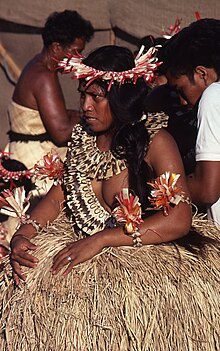
The Kiribati people, also known as I-Kiribati, Tungaru, or Gilbertese, are the indigenous people of Kiribati. They speak the Gilbertese language. They numbered 103,000 as of 2008.[citation needed]
Kosraean people

The Kosraeans or Kusaieans are the indigenous people of Kosrae. They speak the Kosraean language. They number around 8,400 as of 2013.[citation needed]
Marshallese people
The Marshallese people (Marshallese: kajoor ri-Ṃajeḷ , laḷ ri-Ṃajeḷ) are the indigenous inhabitants of the Marshall Islands. They numbered 70,000 as of 2013.[citation needed] Marshallese society was organized into three social classes, the iroji was the chief or landowner that headed several clans, the alap managed the clan and the rijerbal (worker) were commoners that worked the land. The three social classes treated each other well and with mutual respect.[26][need quotation to verify]
Nauruan people
The Nauruans are an ethnicity inhabiting the Pacific island of Nauru. They are most likely a blend of other Pacific peoples.[27]
The origin of the Nauruan people has not yet been finally determined. It can possibly be explained by the last Malayo-Pacific
Palauan people

The Palauans or Belauans (Palauan: Belau, ngukokl a Belau) — are the indigenous people of Palau. They numbered around 26,600 as of 2013.[citation needed] Palauans are not noted for being great long-distance voyagers and navigators when compared to other Micronesian peoples. The taro is the center of their farming practices, although breadfruit has a symbolic importance.[13]
Pohnpeian people

The Pohnpeians or Ponapeans are the indigenous people of Pohnpei. They number around 28,000. They speak the Pohnpeian language.
Pohnpeian historic society was highly structured into five tribes, various clans and sub-clans; each tribe headed by two principal chiefs. The tribes were organized on a feudal basis. In theory, "all land belonged to the chiefs, who received regular tribute and whose rule was absolute." Punishments administered by chiefs included death and banishment. Tribal wars included looting, destruction of houses and canoes and killing of prisoners.[28]
Sonsorolese people
The Sonsorolese are Micronesian people, that inhabit the islands of
The Sonsorolese are both linguistically and culturally most closely related to Carolinians. Ethnographic information about them was left by Jose Somera, a member of the Don Francisco Padilla expedition who discovered the islands in 1710. According to him, their clothing consisted of an apron, cloak and conical hat, and was similar to that described by Paul Klein in 1696 among the Carolinians.[30]
Tobian people
Tobian is a
Tobian is also known as Hatohobei or Tobi. It is closely related to Sonsorolese.
The Tobians share a cultural heritage that shows close ties with peoples of the central Caroline Islands, more than 1000 km to the northeast and on the other side of Palau.[31]
Yapese people

The Yapese people are a Micronesian ethnic group that number around 15,000. They are native to the main island of Yap and speak the Yapese language.
Languages

Fifteen distinct languages are spoken by the Micronesians.[26] The largest group of languages spoken by the Micronesians are the Micronesian languages. They belong to the family of Oceanic languages, part of the Austronesian language group. They descended from the Proto-Oceanic language, which in turn descended via Proto-Malayo-Polynesian from Proto-Austronesian. The languages in the Micronesian family are Marshallese, Gilbertese, Kosraean, Nauruan, as well as a large sub-family called the Chuukic–Pohnpeic languages containing 11 languages. The Yapese language is a separate branch of the Oceanic languages, outside of the Micronesian branch.[14]
Two Malayo-Polynesian languages are spoken that do not belong to the Oceanic languages: Chamorro in the Mariana Islands and Palauan in Palau.[14]
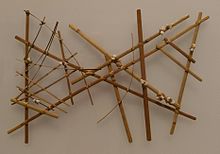
Micronesian navigation techniques are those navigation skills used for thousands of years by the navigators who voyaged between the islands of Micronesia in the open Pacific Ocean. These voyagers used wayfinding techniques such as the navigation by the stars, and observations of birds, ocean swells, and wind patterns, and relied on a large body of knowledge from oral tradition.[32][33][34] Weriyeng[35] is one of the last two schools of traditional navigation found in the central Caroline Islands in Micronesia, the other being Fanur.[36]
Culture
Micronesian culture is very diverse across island atolls
The Micronesian cultures evolved from a common foundation and share a common dominator in the relationship and dependence they have with their ancestral lands. The ancestral land influenced the social organization, family structures, the economy, shared food and common work. The Micronesian family is formed from four equally important components, the household, the nuclear family, the extended family, and a lineage. The family and the community would cooperate with fishing, farming, raising children and passing knowledge to the next generations. Individuals and families would conform their behavior to cooperate with the community.[26]
Authority was based on age, and Micronesians were taught to respect and hold their elders in high regard, which they would express by being silent in the presence of their elders. The elders would mediate and resolve conflicts.[26]
Music and dance
Most Micronesian peoples lacked musical instruments, and thus produced music only by song and chants. Important men would have songs composed about their abilities or deeds, by wives or partners. These songs could live on even after death and give the men a heroic status.[14]
Religion
The traditional religions of Micronesia were extremely heterogeneous. However, very little is known about most of them, as the islands were evangelized very early (from the 16th to 18th centuries) so that the indigenous religions could only survive on a few islands. However, some important manifestations of religious practice and thought can be identified for the entire Micronesian cultural space:[38]
- Similar creation myths (origin of people from mythical ancestors - mostly ancestral mothers)
- Culture heroes (mythical seafarers as bearers of important cultural goods)
- Mythical worldviews (land and sea areas in different "layers" and cardinal points)
- Dualistic concepts (every material thing and every living being has a spiritual double)
- Free souls, which can leave the body in a dream
- Mana(transcendent power that can be transferred to people, but also to natural phenomena, through performance and deeds, among other things)
- Religiously motivated art styles (carvings on traditional meeting houses and religious facilities)
The traditional Micronesian religions emphasized
Mythology
Traditional beliefs declined and changed with the arrival of Europeans, which occurred increasingly after the 1520s. In addition, the contact with European cultures led to changes in local myths and legends.[citation needed]
Gallery
-
A Marshallese house, 1821.
-
A Nauruan warrior, 1880.
-
Kiribati children
-
Presentation of Yapese stone money
-
Badrulchau stone monoliths
-
A building of Nan Madol
See also
- Micronesia
- Micronesian Americans
- Polynesia
- Polynesians
- Pacific Islander
- Taiwanese Aborigines
- Austronesian peoples
- Malagasy people
- Melanesians
References
- Gordon-Conwell Theological Seminary, archived from the original(PDF) on 15 August 2013
- ^ ISBN 9780890961070.
- CiteSeerX 10.1.1.455.1089.
- ^ "Hawaii Health Data Warehouse Race-Ethnicity Documentation" (PDF). August 2011.
{{cite journal}}: Cite journal requires|journal=(help) - ISBN 978-0470016176.
- ISBN 9780071594561.
- JSTOR 25168892.
- ^ Bellwood, Peter (1988). "A Hypothesis for Austronesian Origins" (PDF). Asian Perspectives. 26 (1): 107–117. Archived (PDF) from the original on 1 May 2019. Retrieved 1 May 2019.
- JSTOR 24936983.
- ISBN 9780198576952.
- ISBN 9781920942854. Archivedfrom the original on 2 April 2020. Retrieved 23 March 2019.
- ISBN 9789971696429. Archived(PDF) from the original on 30 December 2019. Retrieved 23 March 2019.
- ^ a b c d e f g Petersen, Glenn (2009). Traditional Micronesian Societies Adaptation, Integration, and Political Organization in the Central Pacific.
- ^ a b c d e f Alkire, William H (1977). An introduction to the peoples and cultures of Micronesia.
- .
- ^ Carson, Mike T. (2013). "Austronesian Migrations and Developments in Micronesia".
{{cite journal}}: Cite journal requires|journal=(help) - ^ "小笠原諸島の歴史". www.iwojima.jp.
- ^ "High-island and low-island cultures". Retrieved 14 November 2021.
- ^ ISBN 982-02-0322-8.)
{{cite book}}: CS1 maint: multiple names: authors list (link - ^ "Banaba: The island Australia ate". Radio National. 30 May 2019. Retrieved 6 June 2019.
- ^ "19. Banaba" (PDF). Office of Te Beretitenti – Republic of Kiribati Island Report Series. 2012. Retrieved 28 April 2015.
- ISBN 9780253014528.
- ^ Prestt, Kate (2017). "Australia's shameful chapter". 49(1) ANUReporter. Retrieved 19 September 2021.
- ^ Kiribati
- OCLC 436267171.
- ^ )
- ISBN 1-55369-293-4.
- ISBN 9780598442437. Retrieved 1 January 2012.
- ^ "Sonsorolese language". Archived from the original on 14 March 2007. Retrieved 14 November 2021.
- ^ "Early European Contact with the Western Carolines". micsem.org.
- ^ Snyder, David.; Adams, William Hampton; Butler, Brian M. (1997). Archaeology and historic preservation in Palau. Anthropology research series / Division of Cultural Affairs, Republic of Palau 2. San Francisco: U.S. National Park Service.
- ^ Holmes, Lowell Don (1 June 1955). "Island Migrations (1): The Polynesian Navigators Followed a Unique Plan". XXV(11) Pacific Islands Monthly. Retrieved 1 October 2021.
- ^ Holmes, Lowell Don (1 August 1955). "Island Migrations (2): Birds and Sea Currents Aided Canoe Navigators". XXVI(1) Pacific Islands Monthly. Retrieved 1 October 2021.
- ^ Holmes, Lowell Don (1 September 1955). "Island Migrations (3): Navigation was an Exact Science for Leaders". XXVI(2) Pacific Islands Monthly. Retrieved 1 October 2021.
- ISBN 0-674-22425-6.
- ISBN 0-226-90728-7. Retrieved 2010-08-04.
- ISBN 978-0520292819.
- ISBN 361101060-X.).
{{cite book}}: CS1 maint: location missing publisher (link

